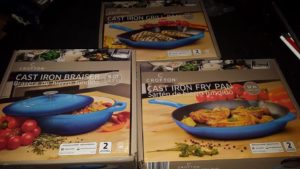Folks don’t usually think of cast iron in December, especially here in Indiana, but with all the things that are going on at the homestead, we definitely have cast iron on the brain here.
About a month ago, Fred and I were shopping at Aldi. We had originally stopped in for a few “essentials”, but by the time we left the store, we’d spent entirely too much money. We got groceries, of course, but we also got flannel sheet sets for every bed in the house. (Did I mention it’s winter in Indiana?) But my favorite find of all was the Crofton cast iron.
 It was the grill pan that caught Fred’s eye. He knew I’d been wanting one for ages, but since I have a glass range top, my cookware has to be flat on the bottom. I can’t have any ridges or rims. And do you folks know how hard it is for a blind person to buy things online based only on the descriptions?
It was the grill pan that caught Fred’s eye. He knew I’d been wanting one for ages, but since I have a glass range top, my cookware has to be flat on the bottom. I can’t have any ridges or rims. And do you folks know how hard it is for a blind person to buy things online based only on the descriptions?
Anyway, I was basically acting like a small child right there in the middle of the store. I took one of the pans out of the box and squealed with delight as I noticed that the bottom was flat and the cast iron didn’t have a surface that felt sandy or bumpy. I tossed the pan into the cart before I even knew how much it was. Then Fred proceeded to tell me that it was only $13 and they had other options too. Boy, was I in trouble!
Next, I checked out a 12″ skillet, and if I hadn’t felt the weight of the pan in my hands, I almost would have suspected that it was some kind of Teflon coated pan. The surface was so smooth, almost like it had been milled. Since I had been struggling with some Lodge cast iron that wasn’t non-stick yet, I snagged that skillet too. It was also $13.
I also ended up snagging a covered braiser. I think I only paid about $25 for that piece.
I know a lot of folks might wonder why I’m such a cast iron fanatic, especially since I have a glass cooktop in my kitchen. I guess I’ll start by dispelling a few myths.
- I thought you couldn’t use cast iron on a glass or ceramic stove top. You can absolutely use cast iron a glass or ceramic cooktop with a few caveats. Remember that cast iron is heavy. Don’t drop it on your cooktop or you’ll break it. Don’t drag it across the cooktop either or you run the risk of scratching it. This isn’t a functional issue, but it’ll likely annoy you. And lastly, make sure the bottom of your pan is FLAT. If it isn’t, you don’t get the right heat transfer to the pan and you run the risk of creating a vacuum in that air gap that can break your stove top. (I saw it happen once when someone set a hot lid on top of a glass cooktop. It made a lid-shaped hole in the cooktop.)
- Cast iron is hard to care for. In my experience, cast iron is a lot easier to care for than the other cookware in my kitchen. In fact, because of that, I almost NEVER use anything but cast iron. Frequent use maintains the seasoning so it doesn’t get rusty, and simple cleaning with hot water and a plastic scrubber or cast iron cleaner will keep your cookware in great shape!
- Cast iron is unsanitary because you don’t clean it with soap. The issue of soap is a debated one. Personally, I don’t use soap on my cast iron unless it’s an enamel coated piece or I’m trying to strip it to reseason it. Outside of those situations, I’ve never had a use for soap with my cast iron, and the logic I use is this. Cast iron does a great job at distributing heat. Heat sanitizes. If one uses cooking temperatures well above the boiling point of water, microbes won’t survive that, thus I don’t worry about getting sick.
A trend that I’ve really come to appreciate in cast iron cookware is the process of enamel coating. I have a large enamel coated “dutch oven” (not the kind that you’d use on a campfire but the kind that’s basically a big covered pot), and it does an amazing job of cooking acidic soups or stews that I might not want to cook in cast iron that hasn’t been coated.
My new skillet and grill pan from Aldi are enamel coated on the handle and the outside of the cookware, and this makes care a lot easier in my view. It means that I only have to worry about seasoning and rust on the cook surface rather than the entire pan.
I have enough cast iron at this point that I may need to reinforce one of my cupboard shelves. The pans that I use most frequently though just sit on my stove top. I’m certain that my fixation with cast iron will mean that I’ll have cookware to pass on to my children when they move into their own homes, and they’ll likely pass it on to their kids too. And my cast iron isn’t even fancy or antique. It’s just used frequently and treated right.
